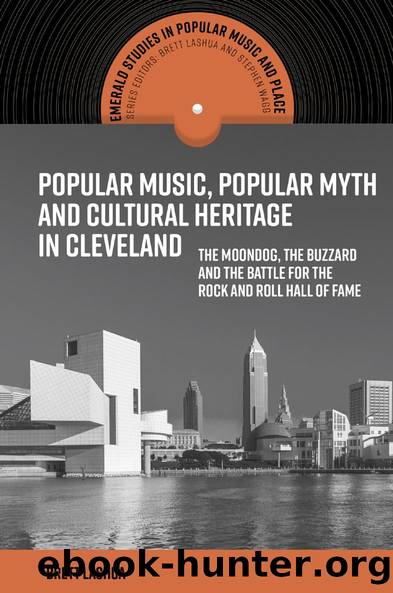Popular Music, Popular Myth and Cultural Heritage in Cleveland by Brett Lashua

Author:Brett Lashua [Lashua, Brett]
Language: eng
Format: epub
Tags: Social Science, Popular Culture, Music, Genres & Styles, Rock, Biography & Autobiography, Pop Vocal, History & Criticism
ISBN: 9781787691575
Google: 3VynDwAAQBAJ
Publisher: Emerald Group Publishing
Published: 2019-08-22T05:30:04+00:00
The Rock ânâ Roll Capital?
Apart from within a circle of dedicated radio personalities, there appears to have been little awareness in Cleveland of its own popular musical heritage. As I noted in the Introduction, one Cleveland journalist had expressed surprise at the mention of Freedâs tenure in Cleveland in Gillettâs (1970) history of rock ânâ roll, The Sound of the City: The Rise of Rock and Roll. As the âKing of the Moondoggers,â interest in Freed was revived by Gillett as âa significant figure in American musical historyâ (McGunagle, 1971, p. 3). Perhaps, in the social and economic problems that troubled the city, Cleveland had in some ways forgotten itself, as a steel town turned to rust. Yet, many radio DJs found ways to celebrate the city. In 1972, local radio producer Billy Bass of emerging FM ârockâ station WMMS began calling Cleveland âthe rock ânâ roll capital of the worldâ (Gorman & Feran, 2007; Halasa, 2009). Another celebratory slogan also coined in the 1970s by WMMS was âCleveland: Where rock began to roll.â The Greater Cleveland Growth Association noticed how WMMS had created âassetsâ (in Gormanâs terms) by championing Cleveland as a rock city, and adopted both mottos in the mid-1980s during the competition to become the location for the Rock and Roll Hall of Fame and Museum (see Chapter 5). Other Cleveland radio stations, including those in the âclassic rockâ format (WNCX [North Coast Express], from 1986) and âoldiesâ stations (WMJI, from 1982) joined the chorus of Clevelandâs rock ânâ roll champions and cheerleaders. In this boosterism, local stations became key narrators in the telling and retelling of the cityâs musical past. This arguably began to transform the city, at least in the popular imagination, if not yet materially. In echoes of anthropologist Clifford Geertz (1973, p. 448), in which âculture is the stories that we tell ourselves about ourselves,â Cleveland, as prominent DJs, and radio broadcasters put it, became a city built on rock ânâ roll. Another WMMS promotional catchphrase soon declared âRock ânâ Roll â born in Cleveland!â The idea that Cleveland was where rock ânâ roll originated was deeply entrenched by 1984, when local DJ and record convention organizer Steve Petryszyn (1984) opined:
You know, Nashvilleâs got country [â¦] and Cleveland is the birthplace of rock ânâ roll. Whether you contest the âCapitalâ boast or not, you canât deny that Cleveland was the birthplace. (p. 7)
Other radio DJs were to play pivotal roles in the shaping of Cleveland as a musical city, one worthy of celebrating its popular music heritage by siting the Rock Hall of Fame there. During the early 1980s in New York City, a âFoundationâ committee of leading music industry figures was organized to plan for the establishment of a Rock and Roll Hall of Fame and Museum. Led by Ahmet Ertegun of Atlantic Records, other members of the Foundation included Rolling Stone magazine co-founder Jann Wenner, Bruce Springsteenâs manager Jon Landau, music industry attorneys Suzan Evans and Allen Grubman, and record executives Seymour Stein, Bob Krasnow, and Noreen Woods.
Download
This site does not store any files on its server. We only index and link to content provided by other sites. Please contact the content providers to delete copyright contents if any and email us, we'll remove relevant links or contents immediately.
Aircraft Design of WWII: A Sketchbook by Lockheed Aircraft Corporation(32139)
The Great Music City by Andrea Baker(30784)
Call Me by Your Name by André Aciman(19905)
The Art of Boudoir Photography: How to Create Stunning Photographs of Women by Christa Meola(18409)
The Secret History by Donna Tartt(18173)
Shoot Sexy by Ryan Armbrust(17559)
Plagued by Fire by Paul Hendrickson(17115)
Portrait Mastery in Black & White: Learn the Signature Style of a Legendary Photographer by Tim Kelly(16873)
Adobe Camera Raw For Digital Photographers Only by Rob Sheppard(16797)
Photographically Speaking: A Deeper Look at Creating Stronger Images (Eva Spring's Library) by David duChemin(16501)
Ready Player One by Cline Ernest(13997)
Pimp by Iceberg Slim(13782)
Bombshells: Glamour Girls of a Lifetime by Sullivan Steve(13689)
The Goal (Off-Campus #4) by Elle Kennedy(13203)
Art Nude Photography Explained: How to Photograph and Understand Great Art Nude Images by Simon Walden(12854)
Kathy Andrews Collection by Kathy Andrews(11328)
The Priory of the Orange Tree by Samantha Shannon(8619)
Thirteen Reasons Why by Jay Asher(8458)
The remains of the day by Kazuo Ishiguro(8400)
